His Do I Care for Beef Steak Bagonia in Water Vase in Winter
Begonia maculata commonly referred to as the Polka dot Begonia derives its name from its unique silver spotted leaves and red undersides.
In fact, it is rumored that Christian Louboutin created his trademark red-heeled shoe to mimic the undersides of the Begonia maculata. So, it shouldn't be surprising to hear that this plant requires specialized attention and care.
Let's look at how to care for Begonia maculata.
Begonia maculata Care
To care for Begonia maculata use sandy clay and loamy soil. Provide bright indirect light between 10k – 20k lux or 2k – 5k foot candles. When watering, keep the soil slightly damp and only water once the top inch (2.5cm) is almost dry about once a week. The ideal temperatures range lies between 67 to 70 degrees Fahrenheit (18 to 22 degrees Celsius). Keep humidity at 50% or higher. Fertilize by-weekly in spring and summer and every two months in Autumn and Winter.
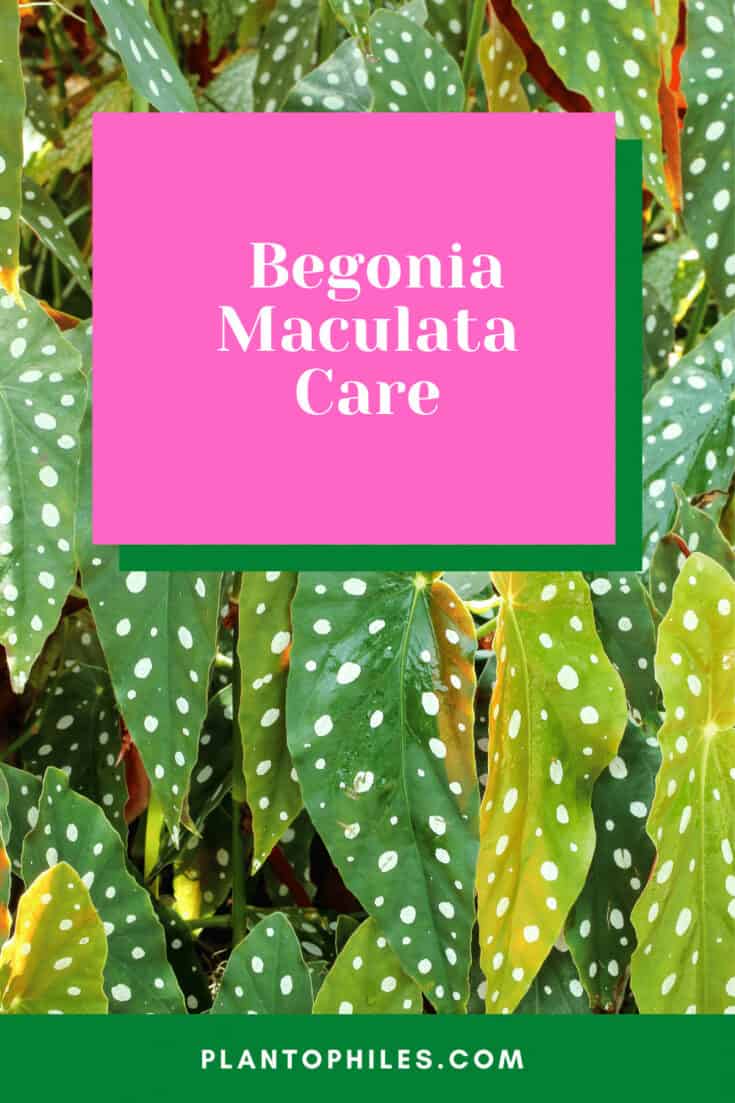
Begonia maculata Care
The Begonia family consists of more than 1300 species and hybrids according to the University of Florida.
Contents

- 1 Begonia maculata Care
- 2 Begonia maculata Care Guide
- 2.1 Begonia Maculata Care Video
- 2.2 Soil
- 2.3 Light
- 2.4 Watering
- 2.5 Temperature
- 2.6 Humidity
- 2.7 Fertilizer
- 2.8 How to Propagate Begonia maculata
- 2.9 Flowering
- 2.10 Growth
- 2.11 Potting
- 3 Begonia maculata Propagation
- 3.1 Begonia maculata: Propagation from leaf cuttings
- 3.2 Begonia maculata: Propagation from stem cuttings
- 3.3 Begonia maculata: Propagation from seeds
- 4 Begonia maculata Care Tips
- 5 How to Water Begonia maculata in Pots
- 6 What Does the Begonia maculata Look Like?
- 7 The Origin of the Begonia maculata
- 8 Where to buy Begonia maculata
- 9 Toxicity of Begonia maculata
- 10 Frequently Asked Questions About Begonia maculata
- 10.1 How do you care for a Begonia maculata plant?
- 10.2 Is Begonia maculata hard to care for?
- 10.3 Is the Begonia maculata rare?
- 10.4 Should you mist Begonia maculata?
- 11 Conclusion
Begonia maculata Care Guide
Begonia Maculata Care Video
Soil
Begonia maculata does very well in a mixture of sand, clay, and loamy soil inside a pot with good drainage.
This plant is highly susceptible to root rot. As such, it is always best to add a layer of pebbles or broken pieces of terracotta pots to the bottom for better drainage.
You should repot the plant in a bigger pot about twice its previous size once the current pot becomes root-bound.
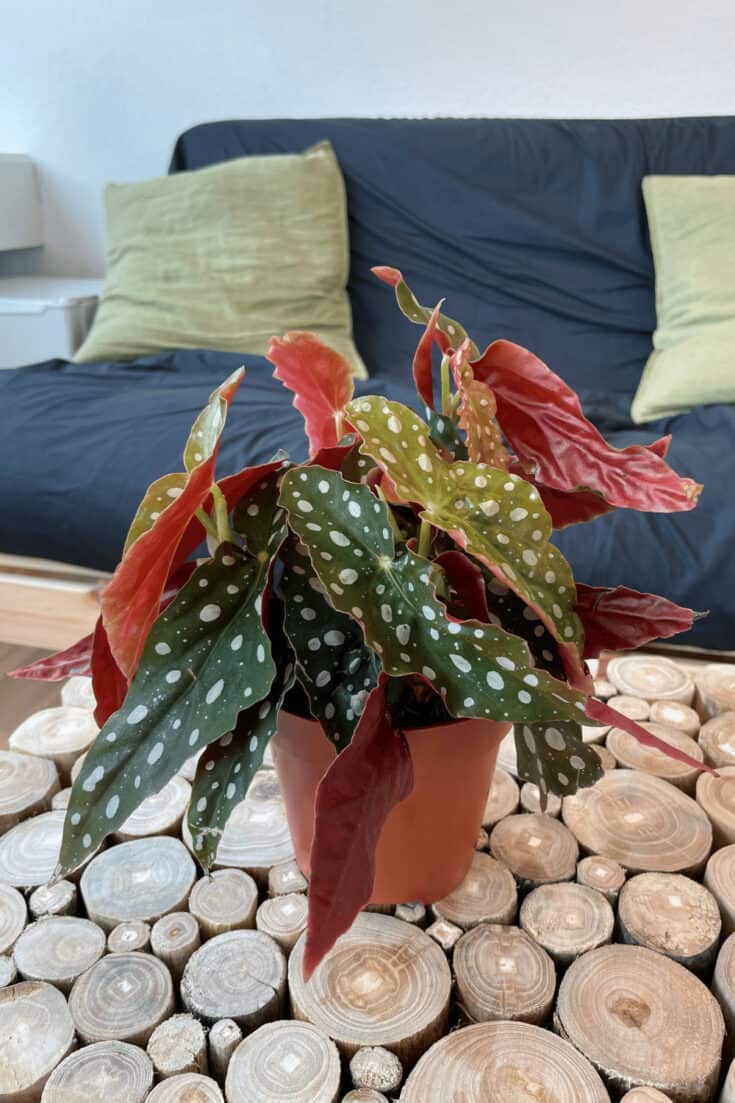
Begonia maculata grows best in sandy clay and loamy soil
Light
Begonia maculata prefers bright indirect or filtered light to thrive. Bright light is considered light between 10k – 20k lux or 2k – 5k foot candles.
The Polka dot Begonia prefers a bit more shade than most indoor plants.
Placing it in a bright, well-lit room away from direct sunlight is advisable to keep those silvery-white olive leaves vibrant.
You can use a light meter to measure the light your Begonia maculata gets.
Let me tell you one thing. I was absolutely shocked to find out how little light my plants receive indoors. Even the ones rather close to a window or a light source. Light falls off so quickly.
If you like to take your plant outside during summer, make sure to place it in the shade away from direct sunlight.
Do not put your grow light too close though and follow the guidelines in the instruction manual.
If the leaves start to appear scorched, you should move your Begonia to a less sunny part of the room or further away from the grow light.

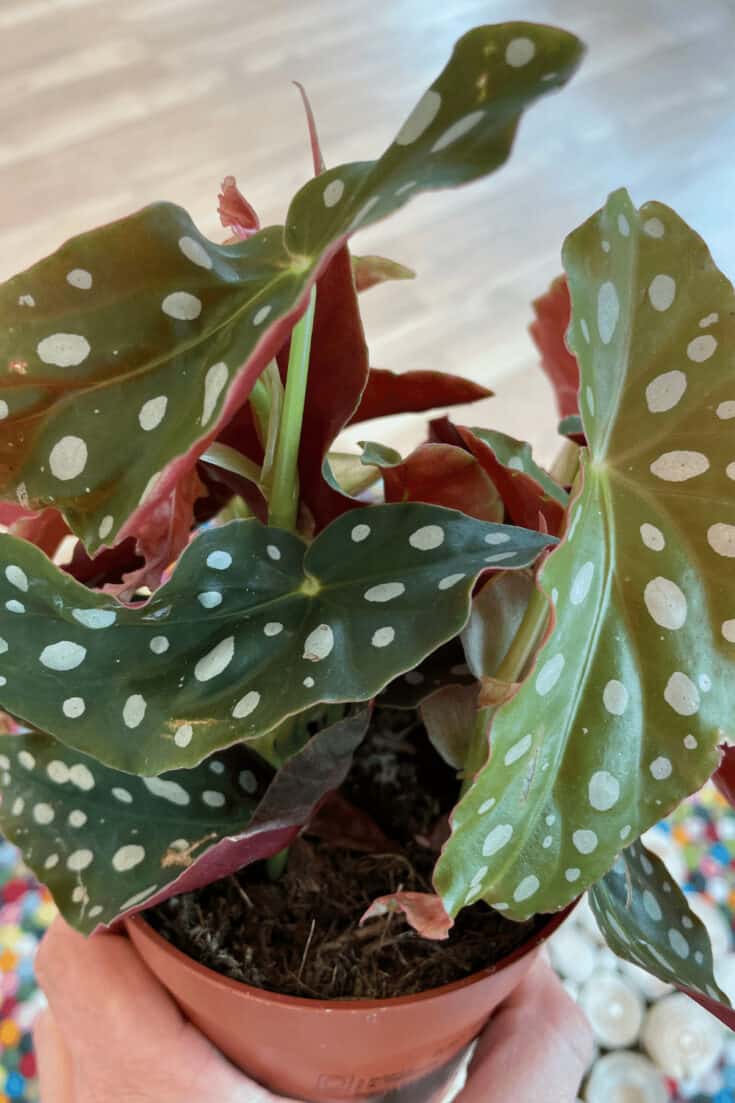
Bright indirect light is best for Begonia maculata
Watering
Keep the soil slightly damp at all times for Begonia maculara and water about once a week when the soil is still damp to the touch. Avoid soggy soils as this will lead to root rot.
Striking the right balance when it comes to watering the Begonia maculata is quite a challenge.
For starters, the soil should be a bit damp, but not overly wet. This is because it is highly susceptible to root rot.
Before watering, you should first test the soil for dampness by dipping a finger into the soil- the top portion should be dry to about an inch deep.
If you are unsure of whether to water it or not, it is actually better to err on the side of caution until the leaves start to show signs of wilting, an indication that there is little water left in the pot.
When watering it, pour water directly onto the soil, ensuring the leaves remain dry.
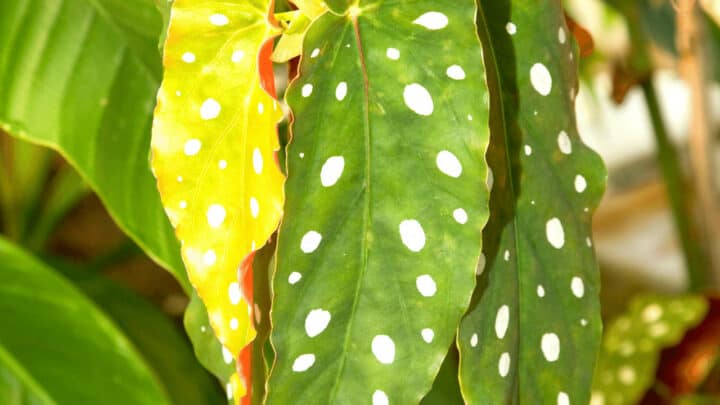
Begonia maculata have beautifully white-spotted green leaves
Temperature
The Begonia maculata is a tropical plant, and, therefore, cannot thrive in cold conditions. Its ideal temperature is between 67 to 70 degrees Fahrenheit (18 to 22 degrees Celsius).
This might be a tall order for anyone in temperate climates, such as Europe, but rest assured temperature-related damage does not happen until temperatures drop to less than 15 degrees Celsius (or 60 degrees Fahrenheit).
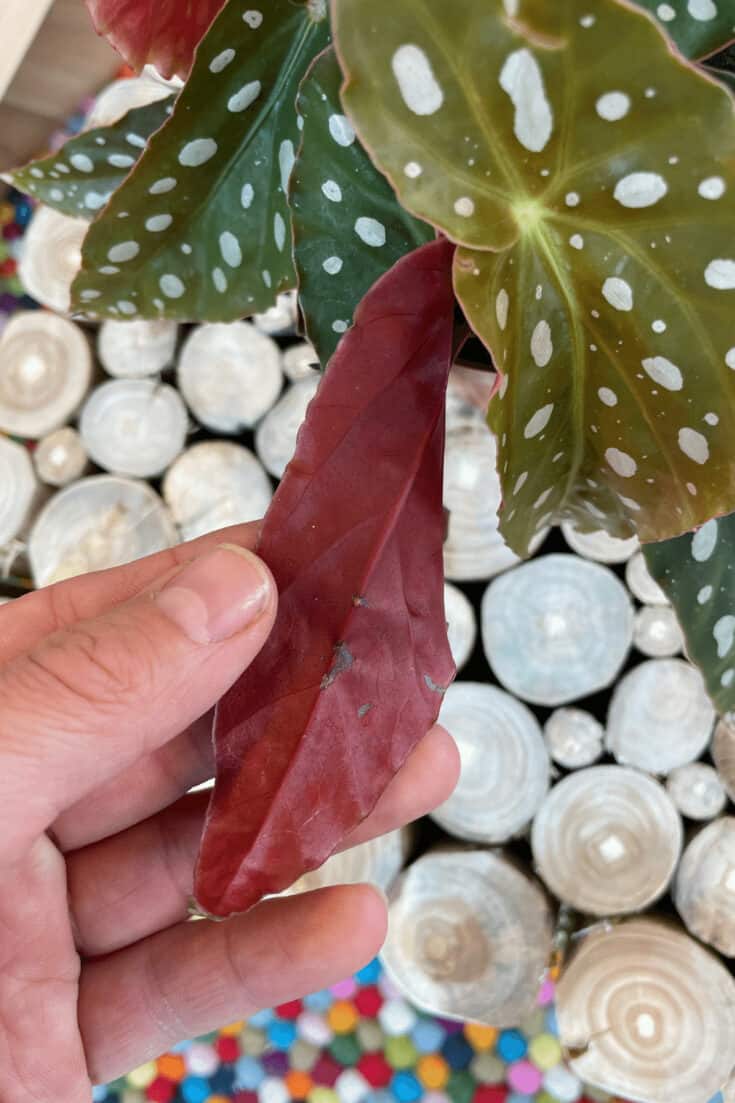
The underside of Begonia maculata leaves is completely red
Humidity
Begonia maculata requires high levels of humidity above 50%. Bathrooms given the right level of light are a great choice as well as a terrarium. Alternatively use a humidifier.
Alternatively, you can set it in your favorite room, but make sure to place a saucer of water near it to ensure it creates the required humidity as the water evaporates.
Caution: Do not place the pot inside the saucer of water because this could make the Begonia maculata roots overly wet. You should also ensure the leaves remain dry because the plant is susceptible to powdery mildew.
A great way to increase humidity and ensure constant high humidity levels for your plants is using a humidifier.

I have reviewed and listed the best humidifiers for houseplants in a blog post.
Fertilizer
It is advisable to fertilize Begonia maculata every two weeks in Spring and Summer using a balanced liquid fertilizer to encourage the growth of healthy leaves and more prominent blooms.
For best results, use half the required dosage of water-soluble fertilizer according to package instructions.
In this case, if the package says you should use one cup of water to dilute the solution, use two cups instead.
Fertilize about once every two months in Autumn and Winter.
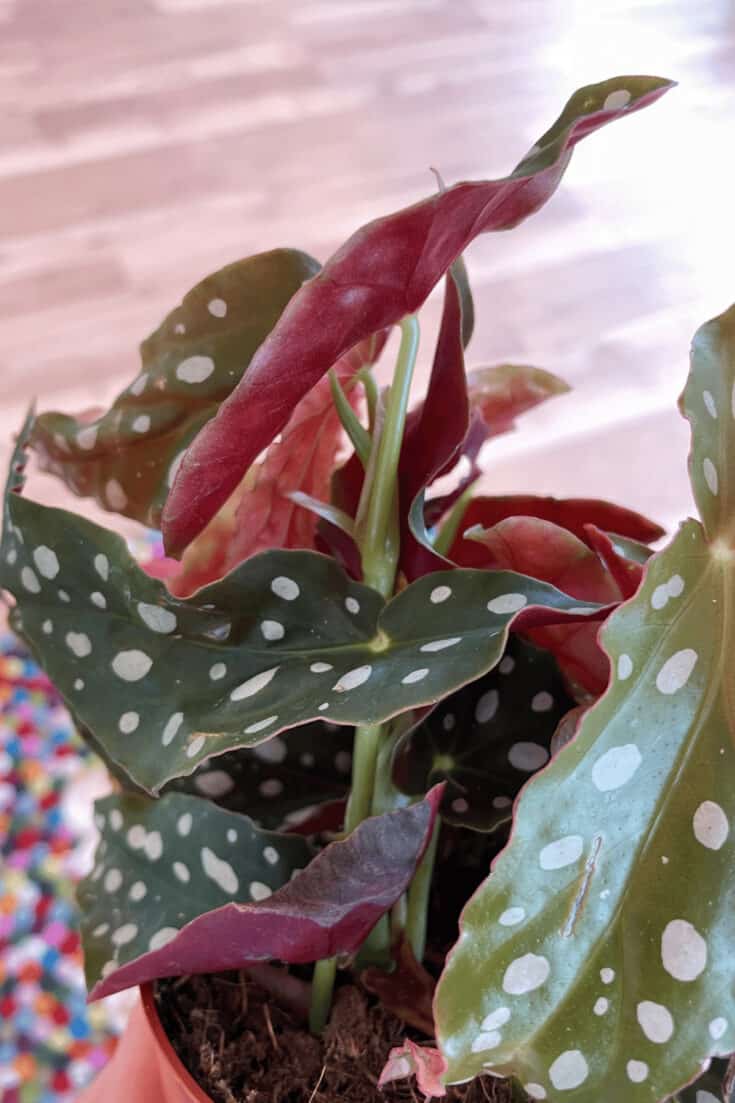
Begonia maculata should be fertilized by-weekly in spring and summer
How to Propagate Begonia maculata
The Begonia maculata is relatively easy to propagate through cuttings. Propagation is best done during the heat of winter when blooming is minimal.
All you have to do is cut off a stem with no flowers just below the bud. Remove the lower leaves and dip them in a jar of water.
Let it remain inside the jar until roots start to form. After that, plant it in a mix of sandy, loamy, and clay soil. Water it so that the soil is lightly moist but not overly soaked.
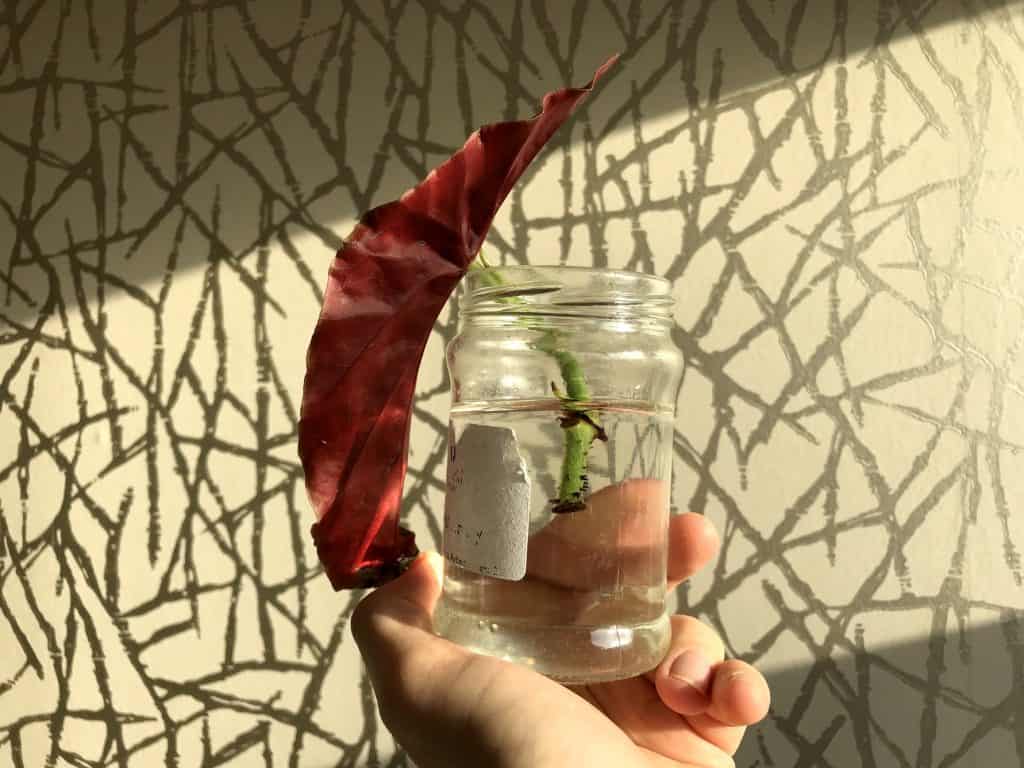
Begonia maculata leaf and stem rooting in water.
Flowering
The Begonia maculata has white flowers with yellow centers and single stems. The Maculata flowers between Spring and Autumn.
You will be rewarded with beautiful white to pale pink Begonia maculata flowers late winter and throughout the spring season.
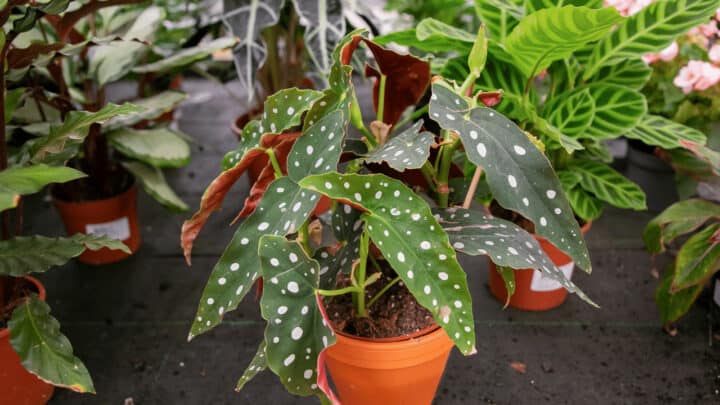
Begonia maculata potted in a terracotta pot
Growth
Begonia maculata grows to about 4.9 feet tall (1.5 m). The leaves are usually asymmetric, extending to approximately 7.9 inches (20 cm) in length.
The upper surface of the leaf is dark green with silvery-white spots, while the reverse is red. Young leaves are pink to maroon in color.
Flowers usually form in single clusters and are white to pale pink. You should remove any wilted flowers on a regular basis to stimulate the growth of new ones.
Similarly, you should prune it regularly to create a beautiful bushy shape. Spring and summer are usually the best seasons to prune it.
Snip back the overgrown branches just above the bud by about half its length. New branches will form from the buds to create a pleasant thick appearance.
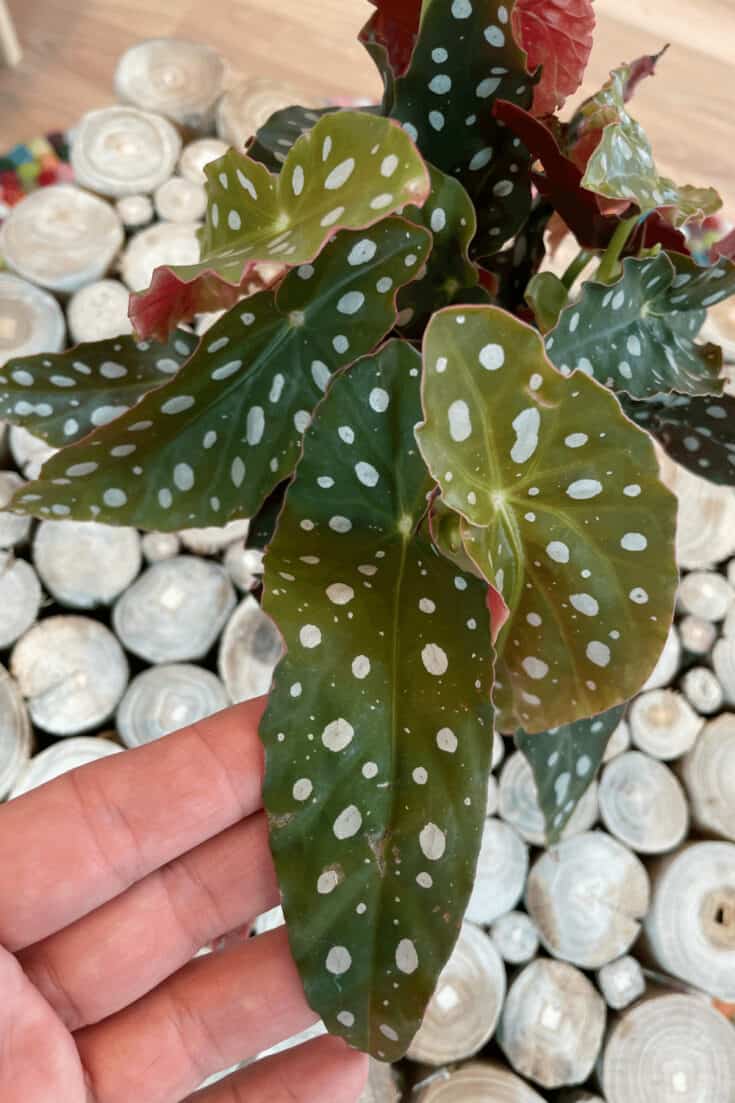
Begonia maculata has white dots on dark green leaves
Potting
Begonia maculata likes to be pot-bound, and thus requires smaller pots than most other houseplants. Regular repotting is also essential during the first years of its life.
Correct potting is an integral part of the growth cycle of the Begonia maculata. The right pot size and type determines, to a large extent, whether the plant will thrive or not.
The best time to repot is during spring. When repotting it, choose a pot that is one size larger than the current one. An ideal container is one with good drainage and great moisture holding capability.
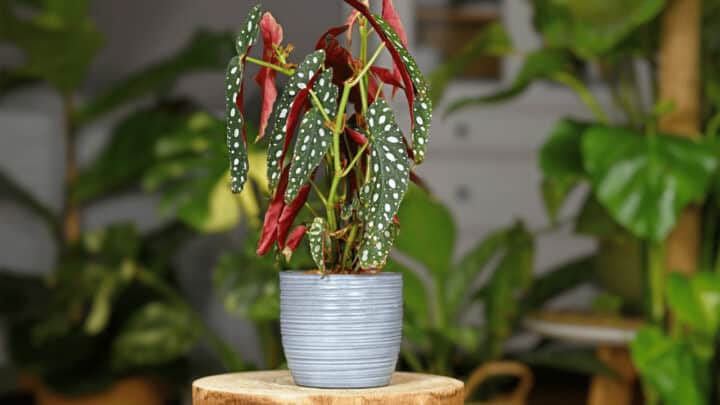
The red backside of Begonia maculata leaves look stunning
Begonia maculata Propagation
You can grow new Begonia maculata plants from seeds, but the easiest and most rewarding way to grow them is to propagate it from cuttings.
Begonia maculata: Propagation from leaf cuttings
To make new Polka dot Begonia plants from cuttings, all you have to do is snip a few fresh leaves from your plant.
Lay the leaves flat upside down and use a clean, sharp knife to slice them into neat wedges. (Be extra careful if you are using a razor blade).
Make sure you have a vein in each wedge piece. You can make a lot of baby Begonia plants using this method.
However, if you need just a few new plants, you do not have to slice the leaves up.
Simply snip out some leaves from the main plant leaving at least 1-inch of petiole still attached to each leaf (the petiole is the stalk that extends from the leaf and attaches it to the stem of the plant).
To make a nursery for your leaf cuttings, fill a small pot with well-draining soil. You can even use a mixture of vermiculite, peat, and perlite moss.
Stick the leaf wedges or petiole stalks into the soil or moss, and store the pot in a plastic bag in a bright and warm place away from direct sunlight.
Make sure the soil in the pot has a little water to keep the cuttings moist, but do not overwater it as this could cause rot.
You should start seeing roots in about three to four weeks from the time you planted them.
After six weeks, you should have your baby plants ready to be moved to your favorite pot or garden.
Alternatively, you can make new Begonia maculata plants by propagating your cuttings in a glass with fresh, clean water.
Food jars are the ideal size for this type of propagation. A single jar can accommodate several cuttings.
Once the roots are about half an inch long, your cuttings are ready to be transferred to new pots.
Begonia maculata: Propagation from stem cuttings
Begonia maculata will also grow from stem cuttings, commonly known as rhizomes. Rhizomes are long thick stems that can be grown under the soil.
Start by cutting a rhizome piece about 1 inch long and press it gently into a pot with a mix of well-draining soil or moss.
Just like their leaf counterparts, ensure they remain moist, but not wet.
Keep them in a warm, well-lit place away from direct sunlight until the roots begin to form in about 5 to 7 weeks.
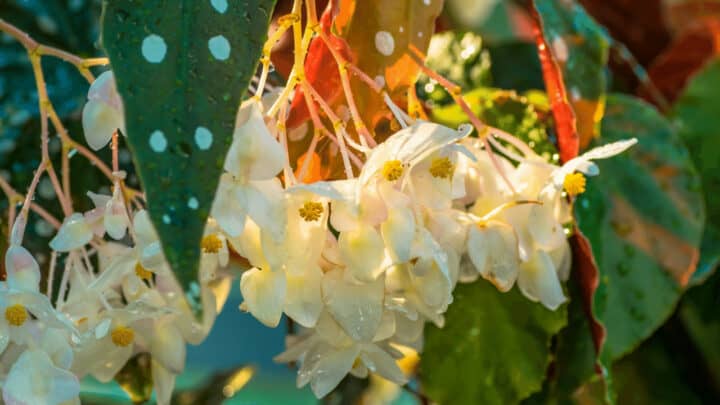
Begonia maculata flowering
Begonia maculata: Propagation from seeds
Growing the Polka dot Begonia from its seeds is harder and usually takes time.
Keep in mind that if the seeds are from hybrid plants, you will not get baby begonias that are a replica of their parents.
This is because hybrids are a mix of different varieties. In fact, you may not even get any baby plants if you use sterile hybrids.
All in all, propagating the Begonia maculata is exciting and enjoyable. Have fun with your new cute baby plants.
Begonia maculata Care Tips
You can always take your plant outdoors, especially during summer, to give it a boost in the sun. Alternatively, you can choose to keep it indoors all year round.
If you do decide to take it outside for a little sun, make sure to bring it indoors before it gets too cold.
Begonia maculatas cannot withstand frost and will wilt and die as soon as they are exposed to frost.
It is advisable to bring it back indoors as soon as temperatures fall below 60 degrees Fahrenheit.
They do not like cold temperatures, and the sudden shock after such temperature change is definitely too much for them.
Ensure to take them indoors in time, and they will thrive and survive beautifully.
According to the University of Connecticut, Begonia maculata can be grown outdoors in USDA zones 10b-11.
How to Water Begonia maculata in Pots
Taking care of the Begonia maculata can be a big challenge because they are extremely sensitive to water.
In fact, I can confidently say overwatering is the leading killer of Begonia maculata houseplants.
As a rule, only water them when they start to show signs of wilting. Allow the soil to actually dry out in between the waterings.
To check the moisture content, dip a finger into the soil about an inch deep before adding any water. Only water it if the soil feels dry.
If you are having a hard time when it comes to watering your plants, I recommend buying a soil moisture gauge for better accuracy.
On the same note, be careful about how you water your plant. The leaves and stems should never get wet.
While the Begonia maculata is not as sensitive as other indoor plants like the African Violets, it is highly susceptible to damage if it gets wet.
To avoid such problems, always water your plant from the bottom rather than from the top.
Fill a tray with water and allow the plant to soak it up through its porous base.
Do not let your plant sit in the water for too long, either. Just let it soak water up to the point where the soil is a little moist. You can then discard the remaining water.
What Does the Begonia maculata Look Like?
Begonia maculata is a gorgeous perennial plant that blossoms with white to pale pink flowers up to three times a year.
The upper side of the leaf is green forming a drastic contrast with the red-Bordeaux reverse.
You'll also notice that its evergreen leaves evolve from olive green to emerald green, and are beautifully speckled with bright spots along the veins of the leaf.
Every season is a show season for the Polka dot Begonia, though you can expect it to mainly flower during late winter up until the end of spring.
Its beautiful white flowers sprout in clusters from a single stem.
The Origin of the Begonia maculata
The beautiful Polka Dot Begonia maculata belongs to the long line of Begonia species. It was first discovered in Brazil in 1982 by an Italian researcher.
However, it is originally native to Mexico, Asia, South Africa, and Central America. It grows best in moist subtropical and tropical climates, but indoor species do well in cooler environments.
This plant undoubtedly shines as an exquisite indoor treasure.
Its scientific name Maculata is derived from its whitish spots, while the other name Begonia is derived from the shape of its stem.
Where to buy Begonia maculata
You can buy Begonia maculata directly from Amazon and save yourself some money!
Toxicity of Begonia maculata
The Begonia maculata is non-toxic but it can still cause irritation and vomiting. Therefore make sure to keep it away from small kids and pets.
Consider Begonia maculata toxic to cats.
Frequently Asked Questions About Begonia maculata
How do you care for a Begonia maculata plant?
To care for Begonia maculata provide well-draining soil. Keep the temperature between 67 to 70 degrees Fahrenheit (18 to 22 degrees Celsius). Water once a week when the top 1 inch (2.5cm) of soil is almost dry and keep it slightly moist. Bright indirect light between 10k – 20k lux or 2k – 5k foot candles is best. Humidity should be above 50%.
Is Begonia maculata hard to care for?
Begonia maculata is not hard to care for but isn't the easiest plant to care for either. There are fussy if they get too much sunlight or if you keep them too wet or too dry. If these aspects are in check it is not difficult.
Is the Begonia maculata rare?
Begonia maculata is not rare. Although you cannot buy it in every online shop or garden center it is readily available in most countries.
Should you mist Begonia maculata?
You should not mist your Begonia maculata. Misting keeps leaves dry for too long if insufficient air circulation is provided. In addition it does little for the overall humidity levels in the air. Put it close to other plants or provide a pebble tray filled with water underneath.
Conclusion
To be completely honest, the Begonia maculata is not the easiest houseplant to take care of.
With its demands of slightly wet soil, special needs in terms of soil that should be well-draining but a mix of loamy soil and clay and is susceptible to root rot.
It's about a lot about striking the right balance and being able to read and interpret your plant the right ways which come with experience.
However, the reward is high as the Begonia maculata has such striking foliage shaped like angel wings.
The adaxial side of the leaf is fully green, covered in white polka dots, and the abaxial side is a striking purple-red color.

Marcel runs the place around here. He has a deep passion for houseplants & gardening and is constantly on the lookout for yet another special plant to add to his arsenal of houseplants, succulents & cacti.
Marcel is also the founder of Iseli International Commerce, a sole proprietorship company that publishes a variety of websites and online magazines.
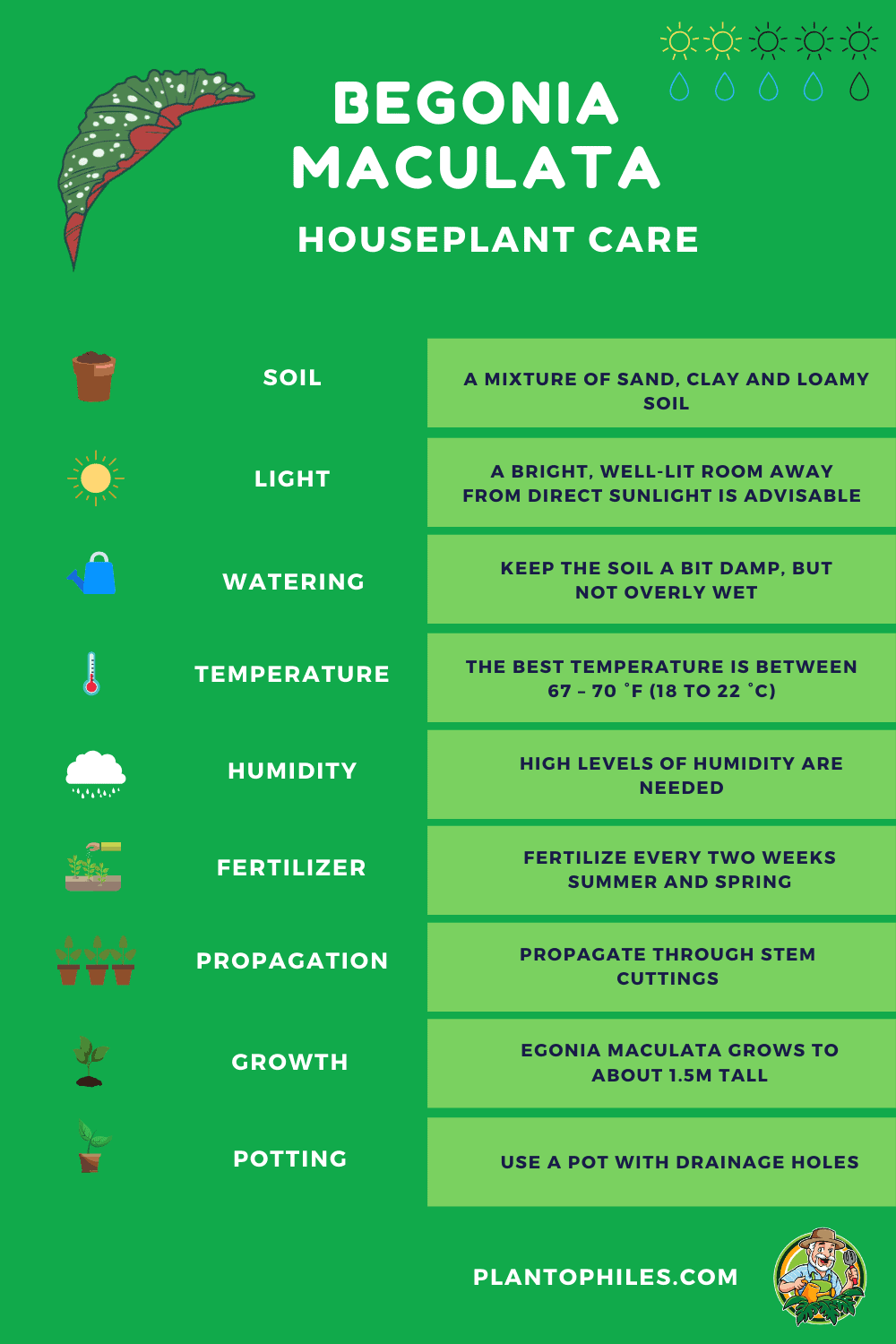
Source: https://plantophiles.com/plant-care/begonia-maculata/
0 Response to "His Do I Care for Beef Steak Bagonia in Water Vase in Winter"
Post a Comment